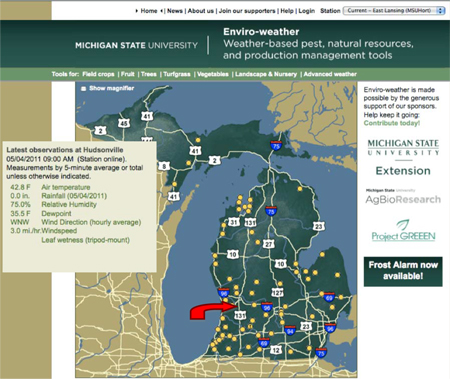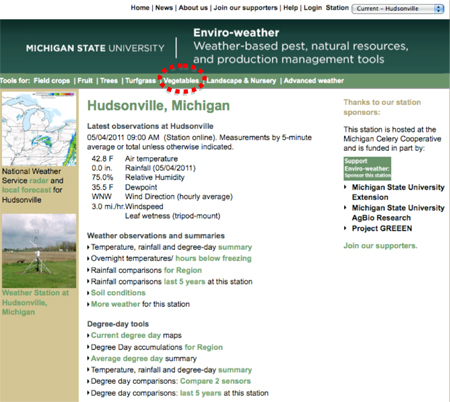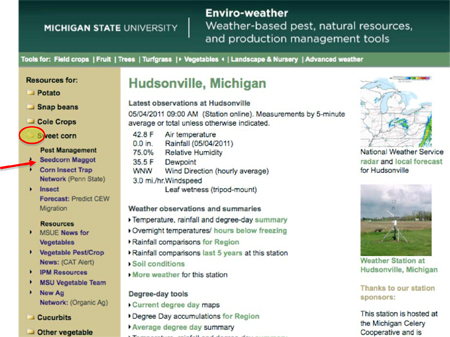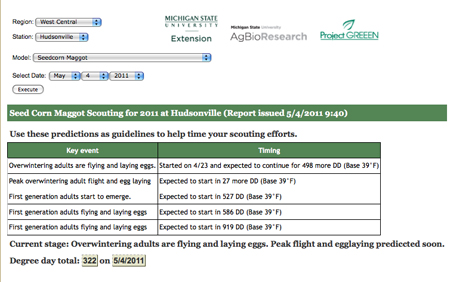New vegetable insect pest predictive tools available on Enviro-weather
New Enviro-weather features will help vegetable growers determine best time for scouting.
New tools on Enviro-weather (www.Enviroweather.msu.edu) can now help vegetable growers determine when to scout for cabbage maggot, seed-corn maggot, variegated cutworm and squash vine borer. Enviro-weather uses data collected by its network of weather stations and uses it to predict when damaging stages of these insects may be present.
Unlike us, insects are “cold-blooded”; their growth and activity depends on external temperatures. How quickly they develop depends directly on the amount of heat that accumulates over a certain base temperature. We know that we can use accumulated heat (as measured by “degree-days”) to predict the appearance of many species of insects, diseases and weeds.
Past research has produced predictive models, based on degree-days for vegetable insect pests. To make sure these predictions are accurate under Michigan conditions, MSU researchers and MSUE educators have collected data on the timing of occurrence of several vegetable pests and compared it to model predictions. After several years of this, we were able to produce pest prediction tools for Enviro-weather.
Check out these new tools by going to the Enviro-weather home page (www.Enviroweather.msu.edu). You will see a map of Michigan with Enviro-weather station locations indicated by yellow dots (Figure 1).

Figure 1.
Select the weather station closest to you by clicking on the appropriate dot. You will be taken to the “station page”, which shows current weather conditions at that location (Figure 2). The station page also contains links to general-use tools (not specific to a particular commodity), such as weather and degree-day summaries. These tools use weather data collected by the selected station (and, in some cases, nearby stations), and have a wide variety of uses for growers. You may want to explore what’s available.

Figure 2.
Tools and other features for specific commodities can be accessed by clicking on the commodity tabs in the light green bar at the top of the page (“Tools for:”). Clicking on the “vegetables” tab will take you to the “vegetable commodity page” (Figure 3). This page includes features and tools available on the station page, PLUS applications for specific crops (left column). Clicking on a folder in this column (e.g., “sweet corn”) opens that folder and displays specific tools available for that crop.

Figure 3.
To access a tool, click on it. Each tool shows a table of “key events” in the lifecycle of the pest (left column), and the expected timing of these events (right column), based on data recorded by the weather station you select (Figure 4). At the bottom of the table, the current stage the pest is expected to be at (based on degree-day accumulations) is shown along with the current degree-day total.

Figure 4.
The cool, wet season has been conducive for seed corn maggot and the seed corn maggot tool on Enviro-weather currently predicts that adults are flying and laying eggs throughout the Lower Peninsula (Figure 4).
As the season progresses, and degree-day total accumulations increase, both the event timing and the current pest stage will change. If you’d like to see what the tool might look like as the season progresses, you can use weather from past years to calculate pest timing. Use the pull down menus near the top of the page to change the starting and ending dates and then click on the “execute” button.
We hope you will find these new insect predictive tools useful and we are continually looking to improve them. We want to hear from you! If you have questions, comments, complaints, suggestions or compliments, please share them with us. I can be reached at bishopb@msu.edu, eweather@msu.edu, or 517 432-6520.



 Print
Print Email
Email


